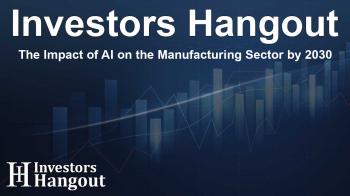The Impact of AI on the Manufacturing Sector by 2030

The Transformative Impact of AI in Manufacturing
The artificial intelligence in manufacturing sector is set for remarkable growth, anticipating a market value of USD 47.88 billion by 2030. This phenomenal expansion is estimated to follow a compound annual growth rate (CAGR) of 46.5% between 2025 and 2030. This surge is largely propelled by the increasing need for sophisticated data management in a rapidly evolving industrial landscape.
Driving Forces Behind AI Growth in Manufacturing
One of the principal factors behind the growth of AI in manufacturing is the ability of industries to manage vast arrays of complex data. Industries are increasingly adopting smart technologies such as automation and the Internet of Things (IoT), which allow for enhanced decision-making and operational efficiency. The incorporation of big data analytics and machine learning models continues to play a crucial role in this evolution.
Innovations Leading to Enhanced Quality Control
Recent advancements in computer vision technology have enabled manufacturers to implement AI-driven quality control processes effectively. These cutting-edge machine learning algorithms are continuously trained using extensive datasets, allowing for real-time inspection and prompt identification of defects during production cycles. By leveraging AI, manufacturers are not only ensuring stringent quality standards but also reducing waste significantly and improving end-user satisfaction.
The Role of Government in AI Adoption
A significant facet of the burgeoning AI market, particularly in Europe, is attributed to governmental support for smart factory initiatives. The European Union has laid out a proactive AI strategy aimed at becoming a leader in AI innovation while ensuring ethical and reliable AI solutions. Policies and joint investments are being enacted to bolster the capability of AI within the region, with a notable commitment of 20 billion euros annually over the next decade directed towards this cause.
Market Segmentation Overview
The market can be segmented effectively based on various components, technologies, applications, and end-use markets. The segment analysis reveals:
Component Segmentation
The hardware segment is anticipated to lead with a substantial market share driven by the demand for specialized components essential for AI functionalities. The software and services segments are equally vital, ensuring continuous innovation and integration of AI capabilities within manufacturing frameworks.
Technological Advancements
Technologies such as machine learning, computer vision, and natural language processing are harnessing the potential of AI. Such advancements are facilitating operations across inventory management, predictive maintenance, and quality control processes, which ultimately supports a more streamlined production architecture.
Growth Across Various End-Use Markets
Several key sectors including semiconductors, electronics, energy, and medical devices are leading the charge in AI adoption. The medical device market, in particular, is capitalizing on AI applications to enhance functionalities such as predictive maintenance and quality control. As companies strive for operational excellence, AI implementations are steadily transforming various manufacturing processes.
Regional Insights
Regionally, North America displays robust growth due to the presence of influential corporations specializing in high-performance hardware necessary for running advanced AI models. This trend is mirrored in Europe as well, where leading nations are investing in AI infrastructures to foster substantial shifts in manufacturing methodologies.
Frequently Asked Questions
What is the projected market value of AI in manufacturing by 2030?
The projected value is USD 47.88 billion.
What is driving the growth of AI in manufacturing?
The growth is driven by the increasing demand for advanced data management and the integration of smart technologies such as IoT and automation.
How is AI improving quality control in manufacturing?
AI enhances quality control through real-time inspections and precise identification of defects during production processes.
What is the role of government initiatives in this market?
Government initiatives, especially in Europe, focus on smart factory projects and providing investments to promote AI technologies.
Which sectors are leading in AI adoption for manufacturing?
Sectors like semiconductors, medical devices, and electronics are at the forefront of adopting AI technologies for enhanced operational efficiency.
About The Author
Contact Caleb Price privately here. Or send an email with ATTN: Caleb Price as the subject to contact@investorshangout.com.
About Investors Hangout
Investors Hangout is a leading online stock forum for financial discussion and learning, offering a wide range of free tools and resources. It draws in traders of all levels, who exchange market knowledge, investigate trading tactics, and keep an eye on industry developments in real time. Featuring financial articles, stock message boards, quotes, charts, company profiles, and live news updates. Through cooperative learning and a wealth of informational resources, it helps users from novices creating their first portfolios to experts honing their techniques. Join Investors Hangout today: https://investorshangout.com/
The content of this article is based on factual, publicly available information and does not represent legal, financial, or investment advice. Investors Hangout does not offer financial advice, and the author is not a licensed financial advisor. Consult a qualified advisor before making any financial or investment decisions based on this article. This article should not be considered advice to purchase, sell, or hold any securities or other investments. If any of the material provided here is inaccurate, please contact us for corrections.

